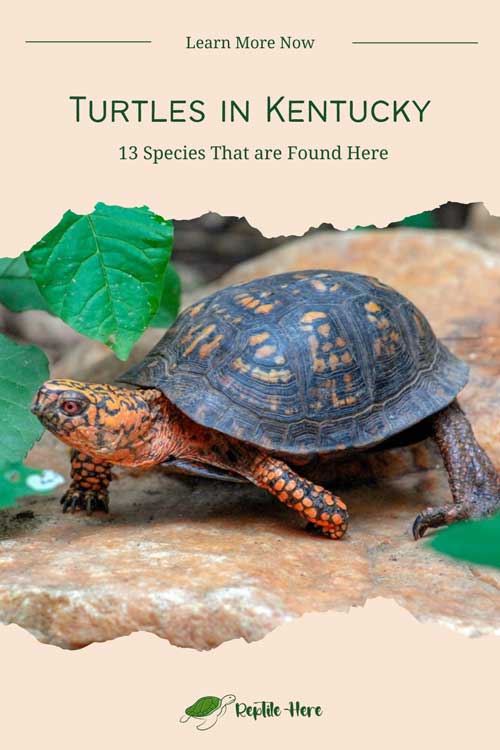Turtles in Kentucky – 13 Species That are Found Here
Kentucky, the Bluegrass State, is home to 13 species of turtles. These include smooth softshell turtles, snapping turtles, mud turtles, musk turtles, map turtles, pond sliders, and box turtles.
Located in the Southern United States, this state mainly receives a humid subtropical climate that offers suitable living conditions for various turtles. It also has woodlands which make a perfect habitat for some turtle species.
However, some turtles in the state have been described as endangered or threatened, and are under special monitoring due to the rapidly declining population.
The following list outlines all the Kentucky turtles and basic info about them, including physical appearance, size, diet, habitat, lifespan, and more.
13 Types Of Turtles in Kentucky
Contents
1. Common Snapping Turtle

- Scientific name: Chelydra serpentina
- Common name: Snapping Turtle
- Family: Chelydridae
- Size: 8 to 18 1/2 inches
- Lifespan: 30 to 50 years or more
- Conservation status: Least Concern
Common snapping turtles are widespread throughout Kentucky. An average adult is pretty large and has a shell length of 18½ inches long.
This species has a chunky head, a long tail, and large webbed feet. The shell color is black or olive and has no distinct pattern. These Kentucky snapping turtles are known for their powerful jaws—they’re so strong that these turtles eat other turtles!
You’ll find them in waterbodies with muddy bottoms. Examples include marshes, ponds, lakes, rivers, and even shallow streams. They generally prefer waters with aquatic vegetation in plenty and foods such as fish, frogs, birds, etc.
These Kentucky turtles generally show docile behavior but can get quite aggressive if taken out of water. The best way to calm it is to take it back to the waters, where it feels safe.
2. Alligator Snapping Turtle
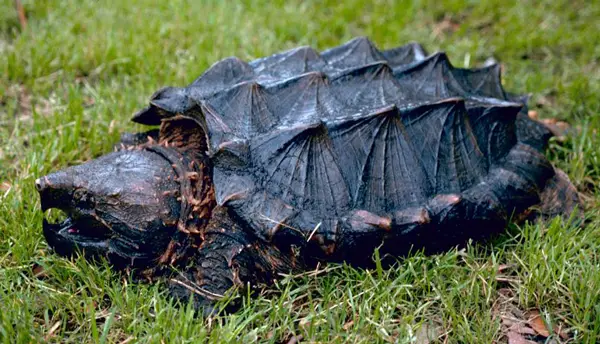
- Scientific name: Macroclemys temminckii
- Common name: Alligator snapping turtle, Snapping turtle
- Family: Chelydridae
- Size: 15 to 26 inches
- Lifespan: 80 to 120 years
- Conservation status: Vulnerable
The alligator snapping turtle is the largest freshwater turtle in Kentucky. This species is large than the common snapping turtle. An adult alligator snapping turtle weighs 15 to 20 inches long.
An alligator turtle is characterized by a long, tough shell with trigonal ridges that resemble the back of an alligator (hence the name alligator turtle). Shell coloring can be black, olive, or brown.
Though some people believe that the green tips on the shell ridges are natural, they’re simply algae.
These alligator turtles also prefer living in deeper waters of rivers, canals, lakes, and swamps in Kentucky.
As omnivorous species, they hunt their prey (but not actively). They have a unique way of hunting where they lie at the bottom of the water body and open their mouth to show their pink work-like appendage to lure their prey. And when the prey gets close enough, the turtle ambushes it!
Another interesting fact about this turtle is its powerful jaws which can bite with a force of up to 1000lbs!
This makes them extremely dangerous turtles and should NEVER be handled in the wild! Mind you, they have injured even the most experienced herpetologists with their bites.
3. Smooth Softshell Turtle
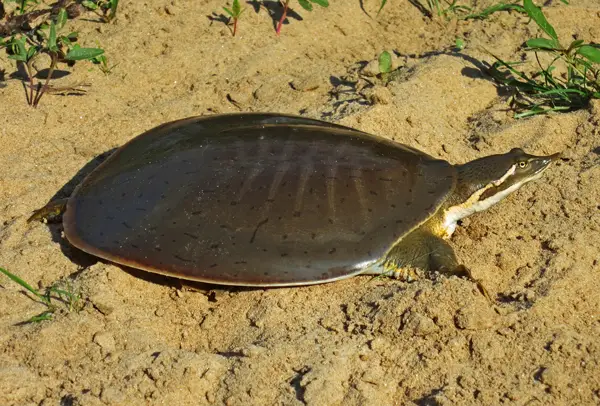
- Scientific name: Apalone mutica
- Common name: Midland Smooth Shell
- Family: Trionychidae
- Size: 6 to 13 inches
- Lifespan: 40 to 60 years
- Conservation status: Least Concern
The smooth softshell turtle boasts its position as the fastest turtle on land in Kentucky! Though most people believe these turtles are slow-moving, they must be quick to enable them to outrun their predators given that their soft shells don’t offer much protection.
Shell color of this turtle species ranges from olive to dark brown. The upper part of its shell features dark markings (with female markings appearing in a blotchier pattern than the males’)
The shell of these turtles also appears rounder and flatter, just like other softshell species.
Note that Gulf Coast smooth turtle (Apalone calvata) is the closes relative of this Midland smooth softshell turtle. The main difference existing between these two species is size, with the Gulf coast turtle reaching a maximum of 12 inches long.
Also, the Gulf coast species has no lines on its face while the midland smooth softshell turtle does.
These turtles like inhabiting waterbodies like rivers and streams in Kentucky that provide an abundance of mud or sand at the bottom. They can also be found in stagnant waterbodies.
Smooth softshell turtles of Kentucky are omnivorous and their diet revolves around aquatic vegetation and insects. However, they have been observed to like meat more than plant matter and will mainly eat snails, insects, and fish.
4. Spiny Softshell Turtle
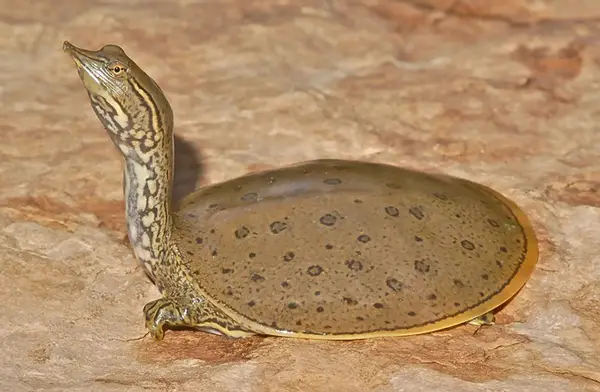
- Scientific name: Apalone spinifera
- Common name: Spiny Softshell Turtle
- Family: Trionychidae
- Size: 5 to 9 inches (males), 12 to 20 inches (females)
- Lifespan: 30 to 70 years
- Conservation status: Least Concern
The Spiny softshell turtle is a medium-to-large freshwater turtle that lives in Kentucky’s lakes, streams, and rivers with muddy or sandy bottoms and little or no vegetation.
Female spiny softshell turtles are usually larger than males. And unlike other turtles, this species has a flexible, leather-like carapace that’s extremely rounded and flattened. The shell color can be olive grey or yellow-brown. Just like other softshell turtles, this species also has a snorkel-like snout.
The young ones feature well-defined round spots that are easily visible on the shell (though these spots become invisible as they transition to adulthood).
Spiny softshell turtles in Kentucky tend to eat anything they find in the waters including crayfish, insects, small fish, and so on. They hunt by burying themselves in the mud or sand while keeping their head uncovered to grab food as it swims by.
These turtles are also able to breathe underwater by taking in oxygen through their throat skin. This is a useful adaptation given that they don’t spend a lot of time out of water.
Other adaptations of these turtles include webbed feed, long claws, and extremely flat shells that enable them to quickly swim away from predators and burry in the muddy bottom of the waters they reside in.
5. Eastern Mud Turtle
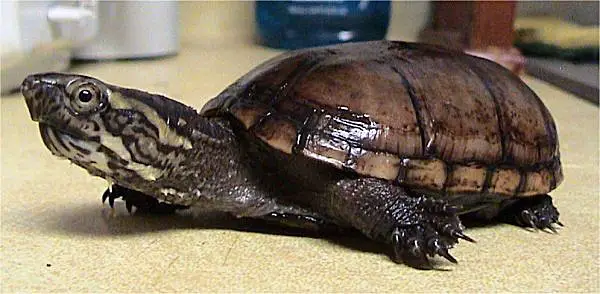
- Scientific name: Kinosternon subrubrum
- Common name: Eastern Mud Turtle, Mud Turtle
- Family: Kinosternidae
- Size: 3 to 5 inches
- Lifespan: 50 years
- Conservation status: Least Concern
The Eastern Mud turtle in Kentucky is found in shallow waters including ditches, marshes, wet meadows, and swamps.
This smaller aquatic turtle species is characterized by a smooth and unmarked shell. Yes, it has an incredible plain look, with its upper shell lacking any patterns. The carapace color ranges from dark yellow to black.
The lower side of the shell is also pretty plain, though it usually appears lighter on the upper part. The key distinction of this mud turtle is the stripes on its head which can be white or yellow in color.
One particular feature that sets this turtle apart from others and makes it easily identifiable is the hinges on its lower shell which form a “K” shape when viewed from the sides.
Just as its name suggests, this turtle lives in water bodies with a soft muddy, or sandy bottom. Thus, they can be found in marshes, swamps, and rivers in Kentucky.
Since the Kentucky eastern mud turtle is omnivorous, it eats meat, fish, snails, insects, and aquatic vegetation as well as plant matter on land.
Unlike other turtles, eastern mud turtles do not hibernate in the cold winter months. Instead, it does the opposite—it becomes dormant in the hot months of summer (this is known as aestivation).
6. Common Musk Turtle
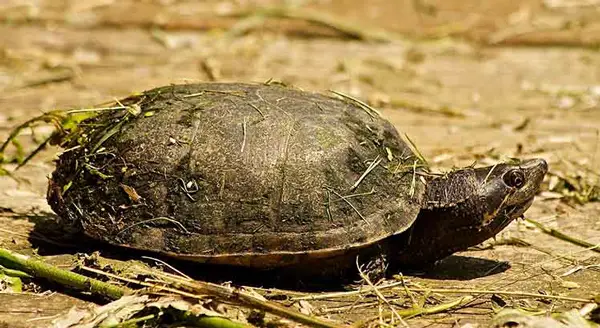
- Scientific name: Sternotherus odoratus
- Common name: Eastern Musk Turtle, Common Musk Turtle, Musk Turtle, Stinkpot
- Family: Kinosternidae
- Size: 2 to 4.5 inches
- Lifespan: 30 to 50 years
- Conservation status: Least Concern
The Common Musk Turtle is another aquatic turtle found in Kentucky’s slow-moving and sluggish streams as well as still water bodies. The turtle usually prefers areas with dark crevices, where it can easily hide. It also prefers lots of plant matter to burrow in and hide.
An average adult eastern musk turtle is quite small (2 to 4.5 inches long). It has a pretty plain appearance with highly consistent colors. Both the shell and skin usually share the same color and can range from dark brown to black.
The turtle shell has one unique feature—a ridge traversing its entire shell length. Besides, it has another distinctive feature: two light-colored stripes on its head.
Common musk turtles of Kentucky are herbivorous and will eat small aquatic or semi-aquatic animals, carrion, and aquatic vegetation. They will also feed on any other vegetation on land.
When it feels threatened, this turtle species emits a foul odor (a musky odor, hence its name). This scent can be detected in water or on land. It can also easily waft through the air to its predators.
Also, these Kentucky turtles are good at climbing trees! This great capability enables them to go high up tree branches to find a safe resting place and avoid predators.
Also read: Turtles in Utah
7. Southern Painted Turtle
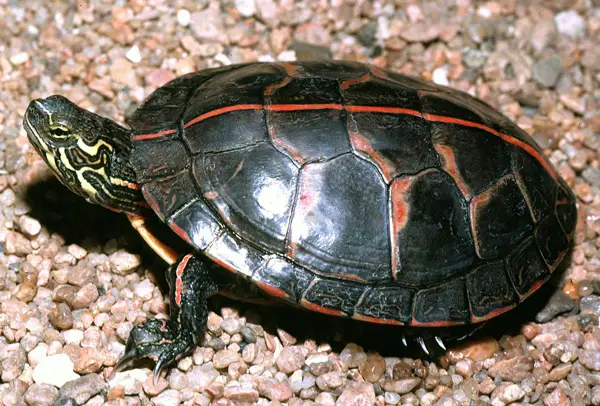
- Scientific name: Chrysemys dorsalis
- Common name: Painted Turtle
- Family: Emydidae
- Size: 4 to 6 inches
- Lifespan: 30 to 50 years
- Conservation status: Least Concern
The Southern painted turtle is a sub-species of painted turtle and the smallest of the painted turtle species in Kentucky. It prefers living in shallow water habits, such as on the edges of lakes or streams.
The average adult size ranges from 4 to 5 inches and is characterized by a distinctive orange or red stripe running down the back of its shell. They also feature a plain, pale-yellow skin belly (plastron) that’s sometimes lightly spotted.
Baby southern painted turtles tend to eat more meat and less vegetation. And as they grow up, they concentrate more on vegetation and less on animal matter.
Nonetheless, these turtles are omnivorous, just like other species. Some of the most common foods for this species include algae, duckweed, dragonfly larvae, and young crayfish.
Most folks like keeping these turtles as a pet due to their small size and unique color patterns on their shells. Not to forget they can live for quite a long time—up to 50 years—and most pet owners end up releasing them back into the wild in Kentucky.
8. Common Map Turtle
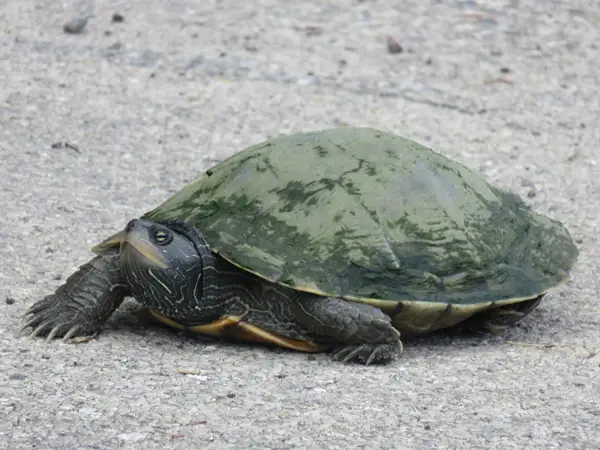
- Scientific name: Graptemys geographica
- Common name: Common Map Turtle, Northern Map Turtle
- Family: Emydidae
- Size: 3 to 10 inches
- Lifespan: 30 to 50 years
- Conservation status: Least Concern
The common map turtle has also been observed in Kentucky. To be more specie, this freshwater turtle resides in the rivers and lakes of Kentucky.
They prefer living in large waterbodies with debris. These offer the perfect spots for basking while the water bodies enable them to spend their hibernation periods in winter completely submerged.
Like other map turtles, this common map turtle gets its name from the map-like pattern on its shell. Its shell is typically darker and ranges from brown to black. The map pattern has a lighter coloration.
The common map turtle of Kentucky is mainly carnivorous and feeds on mollusks such as clams and snails. It will also eat crayfish and insects. And when animal matter gets scarce, it will feed on plant matter.
Note that it may be difficult to spot a common map turtle in the wild in Kentucky. Although active during the day, these turtles are quite timid and will quickly retreat to the waters at the slightest disturbance.
9. Ouachita Map Turtle
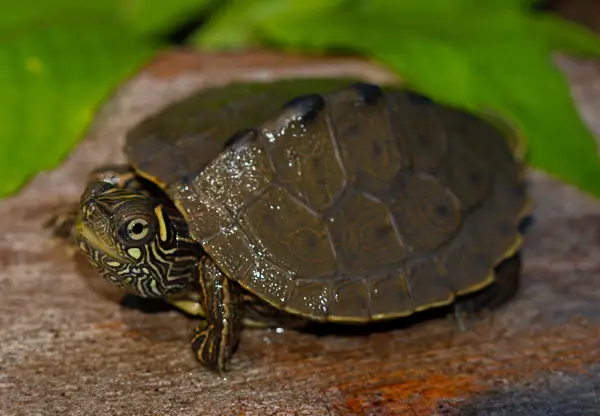
- Scientific name: Graptemys ouachitensis
- Common name: Ouachita Map Turtle, Map Turtle
- Family: Emydidae
- Size: 3 to 5 inches (males), 8 to 10 inches (females)
- Lifespan: 30 to 50 years
- Conservation status: Least Concern
The Ouachita map turtle lives in the northern part of Kentucky and is regarded as one of the less popular map turtle species. The turtle makes an excellent choice of pet for many people since it’s easy to care for.
As for its name, this species is named after the river where it was discovered—Ouachita!
Ouachita turtle is medium to large in terms of size. The average adult female is 3-5 inches long while the male is 8 to 10 inches long. It features thin, yellowing lines that form a web on the turtle’s shell (similar to a contour elevation map).
Moreover, the turtle has brown to olive coloring, with a light spot under both eyes.
The easiest way to identify this Kentucky turtle from other map turtle subspecies is by checking the dots on its face. They usually have 3 prominent spots—under the jawline, under the eye, and behind the eye.
Note that this turtle prefers living in stagnant or slow-moving waters, including ponds, lakes, and streams. of Kentucky It also prefers waters with plenty of vegetation. This species is omnivorous and eats meat, insects, vegetables, fruits, and aquatic vegetation, to name but a few.
10. False Map Turtle
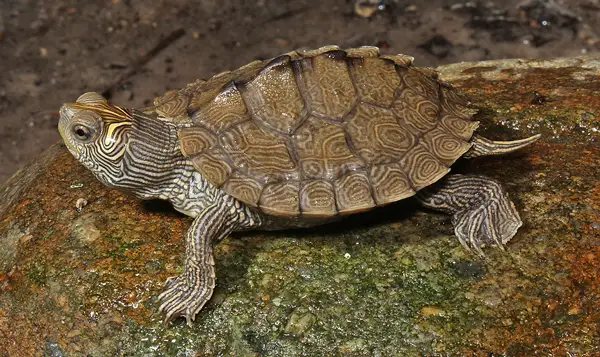
- Scientific name: Graptemys pseudogeographica
- Common name: False Map Turtle, Sawback Turtle
- Family: Emydidae
- Size: 6 to 10 inches (females), 3.5 to 6 inches (males)
- Lifespan: 30 to 50 years
- Conservation status: Least Concern
The False map turtle is another turtle species found in Kentucky. This turtle’s preferred habitat in Kentucky includes rivers, streams, and oxbow lakes of the Missouri and Mississippi river systems.
It is an excellent swimmer and prefers moderate currents and deep waters.
Its upper shell coloring ranges from olive to dark brown, with light-colored lines on its limbs. It also features a line behind its eye that forms a backward “L” shape. The map pattern on its carapace tends to fade as the turtle ages.
Since this map turtle of Kentucky is omnivorous, it feeds on aquatic insects and animals as well as vegetation. It is fond of river snails and crustaceans. Don’t forget it has strong jaws and can give a nasty bite!
Like most of the other aquatic turtles of Kentucky, this map turtle spends most of its waking hours sunning.
The false map turtle is quite shy and quietly and swiftly slides into the water at the slightest signs of disturbance. It likes spending most of its time in water and is most active in climate conditions of over 85 degrees Fahrenheit.
11. Eastern River Cooter
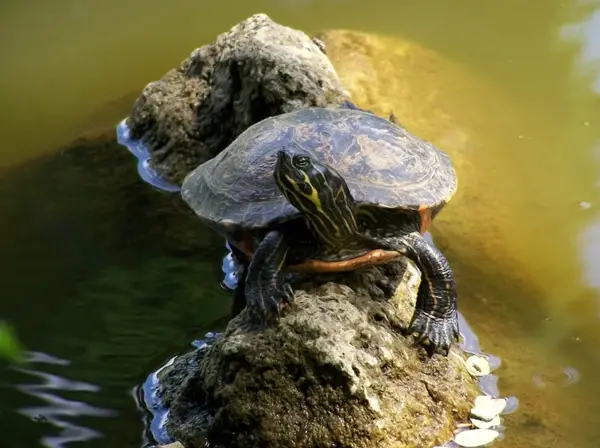
- Scientific name: Pseudemys concinna
- Common name: River Cooter
- Family: Emydidae
- Size: 8 to 12 inches
- Lifespan: 20 to 40 years
- Conservation status: Least Concern
River Cooter turtles are also inhabitants of Kentucky. They’re known to be solitary creatures and often like basking alone in the sun. However, they can be sometimes observed sharing habitat with painted turtles and red-eared sliders.
They’re distinguishable by their brown to olive or dark-green outer shell and lighter c-shaped, concentric markings in their scutes. Their skin can be olive or olive-brown in color, with numerous yellow lines.
Most of these turtle adults are around 8 to 12 inches in size, though it’s not rare to come across females with a bigger size—up to 15 inches.
These turtles are pretty fast both on land and in water. They’re found in various freshwater bodies including lakes, ponds, and rivers in Kentucky. They’re also found in brackish water.
Their diet is primarily herbivorous and mainly consists of various forms of aquatic vegetation and land plant matter, including fruits and vegetables. They’re however known to occasionally feed on insects and snails.
12. Red-eared Slider
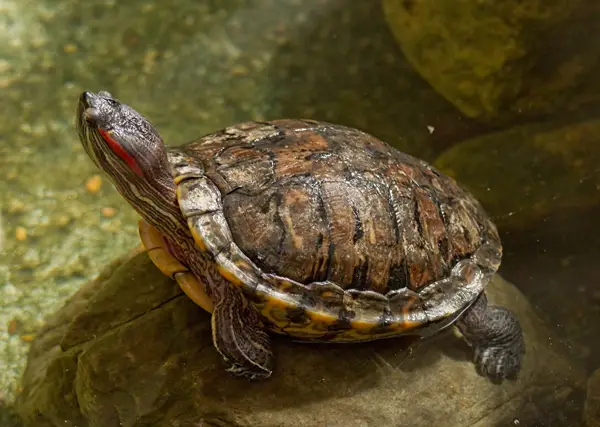
- Scientific name: Trachemys scripta
- Common name: Red-eared Slider, Red-eared Terrapin
- Family: Emydidae
- Size: 7 to 11 inches
- Lifespan: 30 to 40 years
- Conservation status: Least Concern
The red-eared slider is a sub-species of pond sliders and a native species of Kentucky. It is a semi-aquatic turtle and prefers living in marshes, ponds, lakes, and creeks.
A red-eared slider gets its name from the small red stripe surrounding its ears (or behind the eye), and its ability to quickly slide off logs and rocks into the water.
Generally, the skin and shell coloration of this slider can be brown or black, with yellow stripes covering the skin.
The red-eared sliders of Kentucky are pretty large and the adults reach 7-12 in length (though females are generally larger than males).
These Kentucky pond sliders are omnivorous and like eating fish, snails, insects, and aquatic vegetation. They also eat land vegetation, including fruits and vegetables.
13. Eastern box turtle
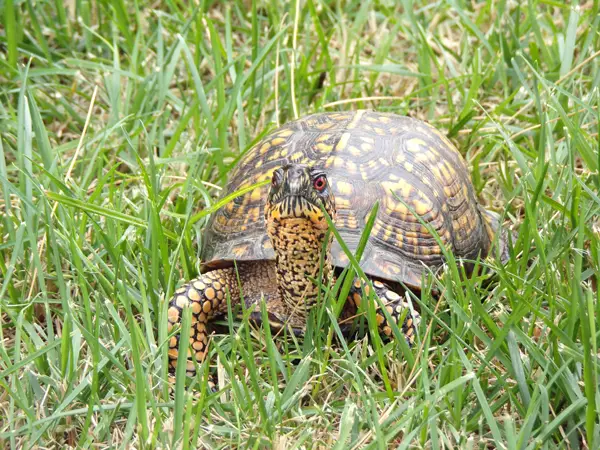
- Scientific name: Terrapene carolina
- Common name: Eastern Box Turtle, Land turtle, Box Turtle
- Family: Emydidae
- Size: 4.5 and 7 inches
- Lifespan: 50 to 100 years
- Conservation status: Vulnerable
The eastern box turtles of Kentucky are found in dense thickets and woodland areas. They prefer these areas due to abundant access to sunlight and food sources nearby.
An adult turtle of this species is about 4.5 to 7 inches and weighs just 2lbs. It has a high, domed shell shape with a ridge running from head to toe. The shell of this turtle has varying colors of olive, brown, and tan.
The variation in markings on the shells of these turtles is so variable that you can’t easily recognize one by looking at the shell alone.
These eastern box turtles of Kentucky are omnivorous and feed on a variety of foods including insects, meat, fruits, vegetables, and various types of vegetation.
Note that eastern box turtles are taken from the Kentucky wild for pet trade, leading to a decline in their population. For this reason, many states have illegalized capturing and selling of this species.
And those in captivity end up dying due to poor conditions or being abandoned or released back into the wild because they’re too demanding to maintain.
Related: Turtles in New Hampshire
Conclusion
This article has just covered the 13 different types of species you’ll find in Kentucky. The state’s humid tropical climate offers perfect living conditions for various turtle species.
Most of the turtles you’ll find in Kentucky are either aquatic or terrestrial. They include smooth softshell turtles, snapping turtles, mud turtles, musk turtles, map turtles, pond sliders, and box turtles.
Remembered, some of the turtles on this list have been labeled as engendered or threatened and are under special monitoring by the Department of Fish and Wildlife to help protect them from extinction.
